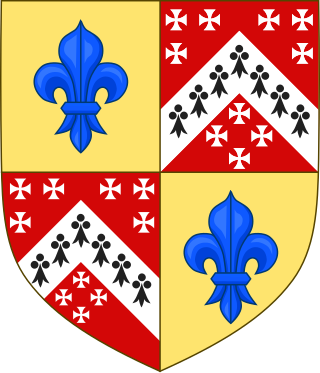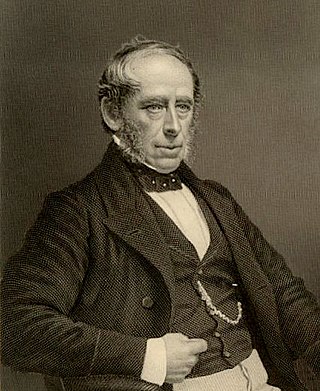
Earl Grey is a title in the peerage of the United Kingdom. It was created in 1806 for General Charles Grey, 1st Baron Grey. In 1801, he was given the title Baron Grey of Howick in the County of Northumberland, and in 1806 he was created Viscount Howick in the County of Northumberland, at the same time as he was given the earldom. A member of the prominent Grey family of Northumberland, Earl Grey was the third son of Sir Henry Grey, 1st Baronet of Howick.

Viscount Hailsham, of Hailsham in the County of Sussex, is a title in the Peerage of the United Kingdom. It was created in 1929 for the lawyer and Conservative politician Douglas Hogg, 1st Baron Hailsham, who twice served as Lord High Chancellor of the Great Britain. He had already been created Baron Hailsham, of Hailsham in the County of Sussex, in 1928, also in the Peerage of the United Kingdom. Hogg was the son of the merchant and philanthropist Quintin Hogg, seventh son of Sir James Hogg, 1st Baronet, whose eldest son James McGarel-Hogg, 2nd Baronet was created Baron Magheramorne in the Peerage of the United Kingdom in 1887.
Baron Marchamley, of Hawkestone in the County of Salop, is a title in the Peerage of the United Kingdom. It was created in 1908 for the Liberal politician George Whiteley, who had previously represented Stockport and Pudsey in the House of Commons. As of 2014 the title is held by his great-grandson, the fourth Baron, who succeeded his father in 1994.

Viscount Knollys, of Caversham in the County of Oxford, is a title in the Peerage of the United Kingdom. It was created in 1911 for the court official Francis Knollys, 1st Baron Knollys, Private Secretary to the Sovereign from 1901 to 1913. He had been previously created Baron Knollys, of Caversham in the County of Oxford, on 21 July 1902. His son, the second Viscount, served as Governor of Bermuda. As of 2012 the titles are held by the latter's son, the third Viscount, who succeeded in 1966. The third Viscountess Knollys was a sister of Baron Farnham: she served as Vice Lord-Lieutenant of Norfolk.

Viscount Portman, in the County of Somerset, is a title in the Peerage of the United Kingdom. It was created on 28 March 1873 for the former Lord Lieutenant of Somerset and Liberal Member of Parliament Edward Portman, 1st Baron Portman. He had already been created Baron Portman, of Orchard Portman, on 27 January 1837, also in the Peerage of the United Kingdom. His son, the second Viscount, represented Shaftesbury and Dorset in the House of Commons as a Liberal. As of 2014 the titles are held by one of the latter's great-great-grandsons, the tenth Viscount, since 1999.
Viscount Camrose, of Hackwood Park in the County of Hampshire, is a title in the Peerage of the United Kingdom. It was created on 20 January 1941 for the prominent newspaper magnate William Berry, 1st Baron Camrose. He had previously received the award of Baronet, of Long Cross in the County of Surrey, in the Baronetage of the United Kingdom, on 4 July 1921, and was created Baron Camrose, of Long Cross in the County of Surrey, on 19 June 1929, in the Peerage of the United Kingdom. His second son, the third Viscount, disclaimed the peerages in 1995 on succeeding his elder brother. However, he had already been created a life peer as Baron Hartwell, of Peterborough Court in the City of London, on 19 January 1968. On his death in 2001 the life peerage became extinct while he was succeeded in the other titles by his eldest son, the fourth Viscount. The first three Viscounts all headed The Daily Telegraph at one point, the first having purchased it from Harry Levy-Lawson, 1st Viscount Burnham, but in the 1980s they lost control to Conrad Black.

Baron Hampton, of Hampton Lovett and of Westwood in the County of Worcester, is a title in the Peerage of the United Kingdom. It was created in 1874 for the Conservative politician Sir John Pakington, 1st Baronet.

Baron Glentoran, of Ballyalloly in the County of Down, is a title in the Peerage of the United Kingdom. It was created on 8 July 1939 for the Unionist politician Herbert Dixon. In 1950 he also succeeded his elder brother as third Baronet, of Ballymenock. His son, the second Baron, was also a politician and served as the last Speaker of the Senate of Northern Ireland. As of 2017 the titles are held by the latter's son, the third Baron, who succeeded in 1995. He is a former Olympic bobsleigh gold medallist as well as a soldier, businessman and politician. Lord Glentoran was one of the ninety elected hereditary peers who remain in the House of Lords after the passing of the House of Lords Act 1999, and sat on the Conservative benches until his June 2018 retirement under the House of Lords Reform Act 2014.
Baron Swansea, of Singleton in the County of Glamorgan, is a title in the Peerage of the United Kingdom and held by a branch of the Vivian family. It was created on 9 June 1893 for the industrialist Sir Henry Vivian, 1st Baronet. He had already been created a Baronet, of Singleton in the County of Glamorgan, on 13 May 1882. He was succeeded by his eldest son, the second Baron. On his death the titles passed to his half-brother, the third Baron. As of 2014 the titles are held by the latter's grandson, the fifth Baron, who succeeded his father in 2005.
Baron Swaythling, of Swaythling in the County of Southampton, is a title in the Peerage of the United Kingdom. It was created in 1907 for the British Jewish Liberal politician, banker and philanthropist, Sir Samuel Montagu, 1st Baronet. He had already been created a Baronet, of South Stoneham House in the County of Southampton and of Kensington Palace Gardens in the County of London, in 1894. As of 2010, the titles are held by his great-great-grandson, the fifth Baron, who succeeded his father in 1998.
Baron Silkin, of Dulwich in the County of London, is a title in the Peerage of the United Kingdom. It was created on 4 July 1950 for the solicitor and Labour politician Lewis Silkin. The peerage was disclaimed by both his eldest son, the second Baron, and the latter's nephew, the third Baron. When the third Baron disclaimed the title in 2002, the barony of Silkin became the first peerage ever to be disclaimed twice; and the only disclaimer since the House of Lords Act 1999
Baron Sanderson of Ayot, of Welwyn in the County of Hertford, is a title in the Peerage of the United Kingdom. It was created in 1960 for the businessman and public servant, Basil Sanderson. He was the son of the shipping magnate Harold Arthur Sanderson, general manager of the White Star Line, and himself was chairman and president of the Shipping Federation. On Lord Sanderson of Ayot's death in 1971 he was succeeded by his elder twin son Alan Lindsay Sanderson. However, he disclaimed the peerage for life the same year.
Baron Monkswell, of Monkswell in the County of Devon, is a title in the Peerage of the United Kingdom. It was created in 1885 for the lawyer and Liberal politician Sir Robert Collier. His eldest son, the second Baron, served as Under-Secretary of State for War in 1895 in the Liberal administration of Lord Rosebery. His grandson, the fourth Baron, disclaimed the peerage on 7 April 1964. He had earlier been a member of the Essex County Council. As of 2020 the title is held by his grandson, the sixth Baron, who succeeded in that year.

Baron Beaverbrook, of Beaverbrook in the Province of New Brunswick in the Dominion of Canada and of Cherkley in the County of Surrey, is a title in the Peerage of the United Kingdom. It was created in 1917 for the prominent media owner and politician Sir Max Aitken, 1st Baronet. He had already been created a baronet, of Cherkley in the County of Surrey, on 3 July 1916. When Aitken died, his son disclaimed the title three days later, stating that "there shall only be one Lord Beaverbrook in my lifetime". Since 1985, the titles are held by the latter's son, the third Baron.
Baron Crawshaw, of Crawshaw in the County Palatine of Lancaster and of Whatton in the County of Leicester is a title in the Peerage of the United Kingdom. It was created on 25 August 1892 for Sir Thomas Brooks, 1st Baronet. He notably served as High Sheriff of Lancashire in 1884. Brooks had already been created a baronet in the Baronetage of the United Kingdom, of Crawshaw Hall and Whatton House, on 9 February 1891. As of 2013 the titles are held by his great-grandson, the fifth Baron, who succeeded his elder brother in 1997.
Baron Clwyd, of Abergele in the County of Denbigh, is a title in the Peerage of the United Kingdom. It was created in 1919 for the Liberal politician Sir John Roberts, 1st Baronet, who had previously represented Denbighshire West in the House of Commons. He had already been created a Baronet, of Brynwenallt in the parish of Abergele in the County of Denbigh, in the Baronetage of the United Kingdom in 1908. Lord Clwyd's father John Roberts had earlier been Member of Parliament for Flint from 1878 to 1892. As of 2016 the titles are held by his great-grandson, the fourth Baron, who succeeded his father in 2006.
Baron Rowallan, of Rowallan in the County of Ayr, is a title in the Peerage of the United Kingdom. It was created in 1911 for the Liberal politician Archibald Corbett. He had previously represented Glasgow Tradeston in the House of Commons. His son, the second Baron, fought in both World Wars, was Chief Scout and served as Governor of Tasmania. As of 2022 the title is held by the latter's grandson, the fourth Baron, who succeeded his father in 1993.

There have been seven Baronetcies created for persons with the surname Lewis, two in the Baronetage of England and five in the Baronetage of the United Kingdom. Only one creation is extant as of 2010.

William Thomas Lewis, 1st Baron Merthyr, known as Sir William Lewis, 1st Baronet, from 1896 to 1911, was a Welsh coal mining magnate.
Major William Brereton Couchman Lewis, 3rd Baron Merthyr, KBE, TD, PC, styled The Honourable William Lewis between 1914 and 1932, was a British barrister and politician.










